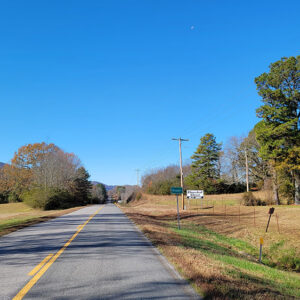calsfoundation@cals.org
Hopper (Montgomery County)
Originally named Parks, the valley community of Hopper sits between the small town of Fancy Hill (Montgomery County) and the Caddo River. Hopper, considered a minor civil division, is at the southernmost edge of Montgomery County with a population of 198 as of the 2020 census.
In the mid-1800s, Mexican War veteran Jack Parks and his wife, Jane Parks, moved from Tennessee to settle on and farm the fertile land they had found in Arkansas. Around 1868, William Jackson Hopper and his wife moved to Parks. Hopper had served in the Union army, which he joined because it paid more than the Confederate army, and was a federal marshal before moving to Parks. Because of his service, Hopper was given land in the area.
In 1881, Jack and Jane Parks donated land for a community building that was constructed that same year to serve as a church, a meeting place, a Masonic lodge, and the first formal school for the area children. Consequently, the town officially became known at this time as Parks. Jackson Hopper and his wife built Hopper’s General Store, which quickly became a centerpiece of the town. Hopper went to the neighboring town of Caddo Gap (Montgomery County) to get the mail for the community every Tuesday, Thursday, and Saturday, and it would be picked up by the recipients at Hopper’s General Store. People would address mail to Hopper so the postmaster at Caddo Gap would know where it was going. As a result, the town of Parks eventually became known as Hopper.
The 1881 building came to be known as Parks School, situated next to a small creek where the children would place their milk from their lunches during the summer to keep it cool. This creek is still known as Parks Branch. Although time has taken its toll on it, the school remains standing and is one of the most photographed buildings in the area.
During the 1920s, the school and community building was expanded due to a growing student body. By 1923, Parks School was officially redesignated Hopper School District No. 30. In 1929, the district consolidated with the Caddo Gap School District. Students up to sixth grade were still being educated in the Hopper school building, while older students were bused to the school at Caddo Gap. The Hopper wing of the district operated until 1952. In 1971, the Caddo Gap School consolidated with the Norman School and became known as the Caddo Hills School District, which is still in operation for the area in the twenty-first century.
In its prime, Hopper had a post office, three stores, a grist mill, a stave mill, and a sawmill. The old store/post office still stands in the twenty-first century, although it is not marked as a town site. Hopper is primarily a farming community, with many residents traveling elsewhere for work.
One of the unique sites in Hopper is the Hughes Space and Communications Company satellite dish. Founder Howard Hughes was well known in the film industry but also had an obsession with aviation and was the first to launch a satellite into the geosynchronous orbit, which is the orbit that makes it possible to transmit information to satellites all over the world. Built in the 1960s, the Hughes Corporation Satellite dish was used as a way to communicate with satellites in space. The project, known as the Arkansas Research and Test Station, was a collaboration with the University of Arkansas (UA) in Fayetteville (Washington County) and was originally slated to be located in Fayetteville, but due to the proximity of microwave lines, highways, and the city, the location had to be changed. Montgomery County came up as a possibility during an Arkansas General Assembly meeting. The $2 million satellite dish was built in 1965–1966. The satellite project ceased operation in 1969, but the dish still remains. The land the satellite sits on became private property.
One of the main attractions in Hopper was a place called the Blue Hole. Located between Hopper and Fancy Hill, it came to be through the mining of minerals by the company Millcam. After mining ceased, the left-over hole began to fill with water. The water was extremely concentrated with mineral deposits, giving the cool, clear, deep water a blue color. It was thought that the Blue Hole could not sustain any life inside the water, but that was later disproven. The Blue Hole was purchased and shut down for visitors after a diving accident that left a man paralyzed.
Several people of note have come from Hopper. Faye Bohannon was a top executive with the Arkansas Department of Education for many years. Frank Davis and his brother Danny Davis both helped lead their high school basketball team to several championships. Their team went undefeated for thirty-six straight games, and both men played college basketball. Each set several basketball records, some of which still stand, and both were drafted into the NBA.
For additional information:
Manning, Shirley Shewmake. Family Scrapbook Montgomery County, Arkansas. Norman, AR: 2011.
Montgomery County, Our Heritage: Quartz Crystal Capital of the World. Delight, AR: Montgomery County Historical Society, 1987.
Kayla Ledbetter Caldwell
Glenwood, Arkansas
 Entering Hopper
Entering Hopper  Hopper Cemetery
Hopper Cemetery  Hopper Church
Hopper Church  Hopper Community Building
Hopper Community Building  Hopper Street Scene
Hopper Street Scene  Montgomery County Map
Montgomery County Map 




Comments
No comments on this entry yet.